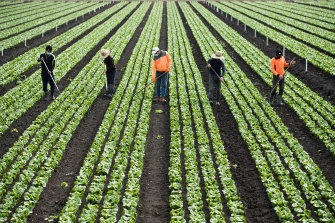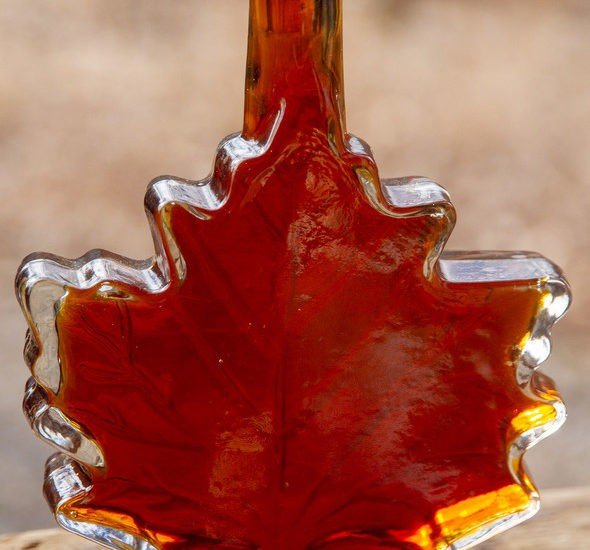
Normally he would employ 15 seasonal workers from the Solomon Islands and Samoa over summer, who he says are skilled, hard workers. But this year, due to the pandemic, he hasn’t been able to employ any. Most backpackers have left the state too.
Mr Boratto says Coles and Woolworths are predicting a 20 per cent increase in demand for his salad leaves over Christmas, with Australians celebrating with barbecues after a gruelling year.
“I looked them in the face and said, ‘Yeah? What do you want me to do? I can’t get workers.’ “
A report commissioned by Hort Innovation released on Wednesday predicts a shortage of up to 26,000 workers to pick and pack fruit and vegetables in Australia over the next six months due to the COVID-19 pandemic.
The report by Ernst & Young predicts seven key production regions will be be hardest hit: Cairns and Wide Bay in Queensland, North West Victoria and Shepparton in Victoria, Coffs Harbour Grafton and Murray in New South Wales and South Australia’s south eastern region.
The worker shortage is likely to peak in March next year with more hardship if the international border reopening is deferred past March.
The National Farmers Federation has called on state and federal governments to urgently bring in seasonal workers and offer incentives to domestic workers to pursue employment in horticulture.
It says industry continues to recommend a relocation payment of $1200 to move to the regions and a seasonal worker incentive trial that would allow participants to earn up to $5000 a year from seasonal horticultural work without it being included under the social security income test.

Dino Boratto in his tractor.Credit:Jason South
The National Farmers Federation’s 10-point approach to addressing worker shortages also includes restarting the working holiday maker program in the next three to six months and introducing a harvest work visa in the longer term
AUSVEG – Australia’s peak industry body for vegetable and potato growers – urged state and federal governments to ensure growers had access to the domestic and dedicated seasonal workers they needed to harvest their fruits and vegetables.
“Immediate interventions are required, including the urgent prioritisation of the Seasonal Worker Program to resume flights to neighbouring countries with ready workers wanting to work on our farms and appropriate incentives in place for domestic workers who are willing and able to work on our farms,” said AUSVEG CEO James Whiteside.

Rae McFarlane in a spinach field.Credit:Jason South
Australian Fresh Produce Alliance chief executive Michael Rogers said the critical shortage of workers had started to affect production. “A number of growers in Queensland are on the verge of not being able to harvest fruit and vegetables,” he said.
Mr Rogers said there were real concerns in NSW about the upcoming cherry harvest, while Victoria’s stone fruit season was also nearing. “There are just not the backpackers in the country any more under the working holidaymaker program,” he said.
The Department of Home Affairs said visa application and arrival numbers had been adversely affected by COVID-19 and related travel restrictions. A spokesperson said as of August 31 there were just 71,833 working holidaymakers in Australia, compared to 127,780 at the same time last year.
The number of seasonal workers in Australia had shrunk from 6174 to 2365 in the past 12 months. (A further 4806 former working holidaymakers and seasonal workers had been granted visa extensions to continue working in critical sectors.)
On August 21 the government announced the restart of the Pacific Labour Scheme and Seasonal Worker Program to help fill labour shortages in key industries, particularly the agriculture sector. This followed a pilot to address labour shortages affecting Northern Territory mango farmers, with 162 workers from Vanuatu beginning work in September after two weeks in quarantine.

Workers from Malaysia and Vietnam work a cos lettuce field.Credit:Jason South
Mr Whiteside from AUSVEG said the pilot demonstrated there was an appetite to get workers on fruit and vegetable farms to perform much-need picking, harvesting and packing roles.
However, he said it continued to be a slow process to deliver flights with workers from nations such as Tonga and Papua New Guinea to fill critical farm labour shortages.
Mr Boratto said he would happily pay for Pacific workers to quarantine at his accommodation in Bacchus Marsh.
“I am going to lose a million dollars,” he said. “The workforce is my biggest problem. I could grow three times the size in one year without blinking, but I just don’t have the staff.”
He said he had tried to employ Australians but they often didn’t show up to work. “I just can’t find Aussies. No one wants to work in the farming industry. The people of today don’t want to work hard.”
Now Mr Boratto has decided to sacrifice his cabbages. “When it comes to the crunch, I am going to cut what is least valuable. I will just plough it under the ground. Sooner or later I’m going to have to make the big call to reduce production by 50 per cent.”
Jewel Topsfield is a senior reporter at The Age. She has worked in Melbourne, Canberra and Jakarta as Indonesia correspondent. She has won multiple awards including a Walkley and the Lowy Institute Media Award.

